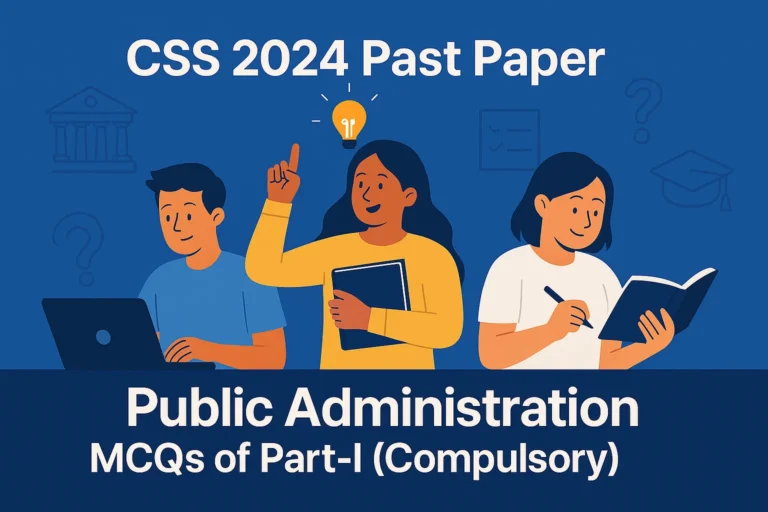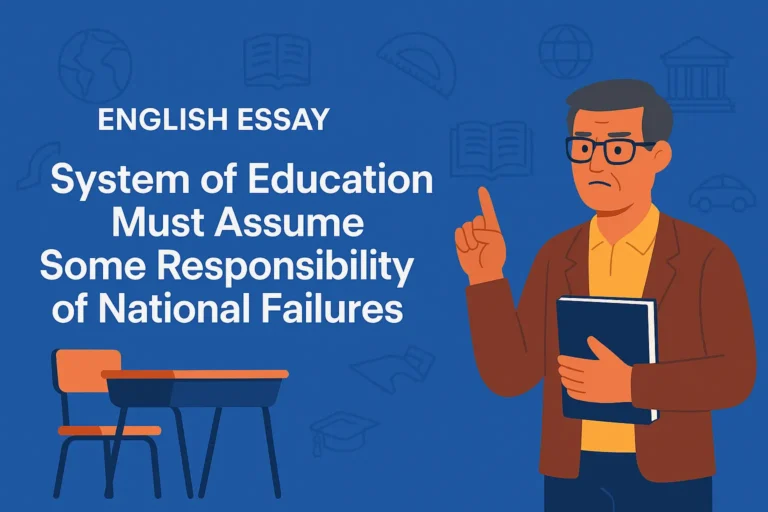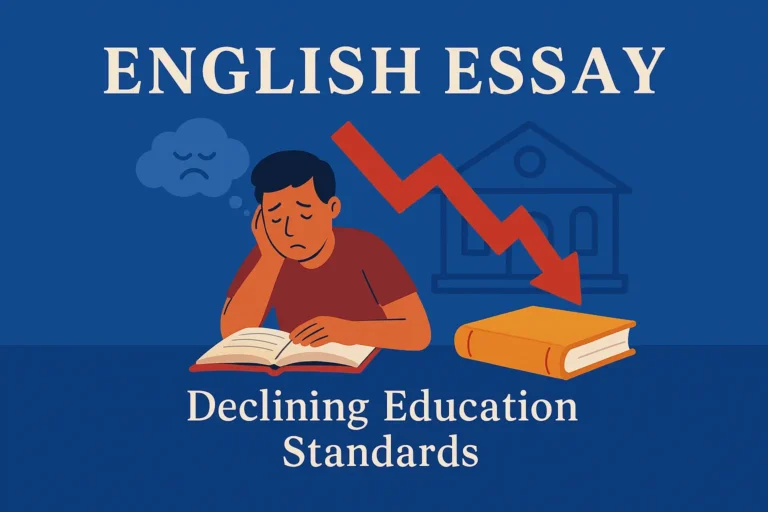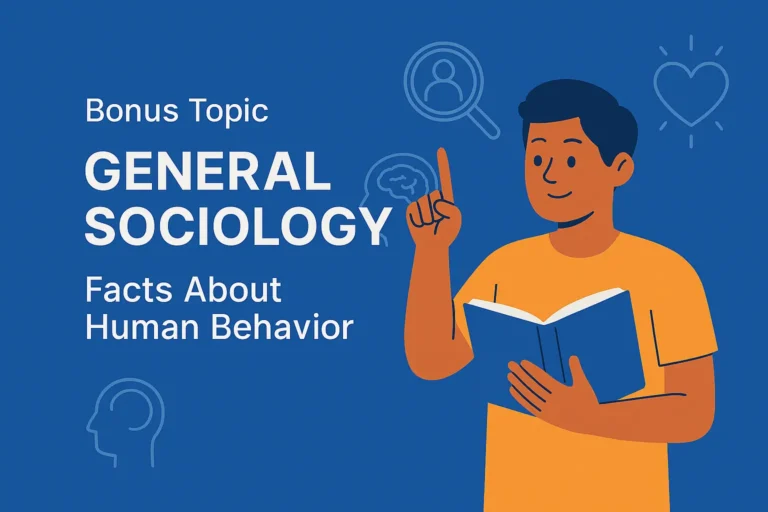CSS 2021 Solved Past Paper – Journalism & Mass Communication Part-II (Compulsory)
Below is the solution to PART-II (COMPULSORY) of the CSS 2021 Journalism & Mass Communication Paper.
Question 2
Is communication the process of creating shared meaning? Explain in detail.
Introduction
Communication is not just about talking or sending messages. It is actually a process where two or more people try to understand each other by sharing ideas, feelings, or information. So yes, communication is truly the process of creating shared meaning between individuals or groups. Without this shared meaning, real communication can’t happen.
Definition of Communication
Communication is the exchange of messages between a sender and a receiver using different channels like spoken words, written texts, pictures, or even gestures. But just sending a message is not enough. The main goal is to make sure the other person understands the message the way we mean it.
What is Shared Meaning?
Shared meaning means both the sender and the receiver understand the message in the same way. It is like being on the same page. For example, if a teacher says something in class and all the students understand it correctly, shared meaning is achieved. But if students misunderstand, then communication has failed.
Communication as a Process
Communication is a process because it happens in steps. These steps include:
- Sender/Encoder – the one who sends the message.
- Message – the idea or information that is being communicated.
- Channel/Medium – how the message is sent (spoken, written, etc.).
- Receiver/Decoder – the person who receives and interprets the message.
- Feedback – the receiver’s response that tells if the message was understood.
- Noise – any disturbance that stops clear understanding (like bad signals, language barriers, etc.).
These elements work together to create understanding and shared meaning.
Why Shared Meaning is Important?
- Without shared meaning, communication becomes confusing.
- It avoids misunderstandings.
- It helps build trust and stronger relationships.
- In media, if journalists don’t create shared meaning, public opinion can be misled.
- In business, poor shared meaning can lead to wrong decisions.
Examples of Shared Meaning in Real Life
- In Media: News reports should be clear so that the public can understand issues correctly.
- In Classrooms: Teachers use examples and body language to help students understand.
- In Families: Parents and children need clear talk to avoid conflicts.
- In Diplomacy: Countries must use careful language to keep peaceful relations.
Barriers to Shared Meaning (Communication Barriers)
- Language Differences – people speaking different languages.
- Cultural Differences – different customs or beliefs.
- Technical Jargon – using hard or unknown terms.
- Noise or Distraction – background noise or weak internet in online talks.
- Emotional Filters – being angry or sad can change the way we understand things.
How to Create Shared Meaning?
- Use simple and clear language.
- Use feedback to check understanding.
- Avoid assumptions.
- Respect cultural and social differences.
- Use visuals or examples where needed.
Conclusion
Communication is definitely the process of creating shared meaning. If there is no shared understanding, the whole purpose of communication fails. Whether it is personal talk, classroom teaching, media reporting, or business meetings – the main goal always stays the same: to understand and to be understood. So, shared meaning is the heart of all real communication.
Question 3
Describe the traditional model of adoption and diffusion of innovations. Explain how the qualities of innovations affect the adoption process.
Introduction
The adoption and diffusion of innovations is a process that explains how new ideas, technologies or products spread among people or society. This model was developed by Everett Rogers in his famous theory called Diffusion of Innovations. It shows how some people accept new things early, while others take more time.
What is Adoption and Diffusion?
- Adoption means when a person accepts and starts using a new idea or product.
- Diffusion means how that idea or product spreads across a social system or group over time.
This model is useful in communication, marketing, agriculture, health campaigns, and even technology fields.
Traditional Model of Adoption and Diffusion (Rogers’ Model)
Rogers divided adopters into five categories:
- Innovators (2.5%)
- These are the risk-takers.
- They are curious and try new things first.
- Usually well-educated and have financial resources.
- Early Adopters (13.5%)
- They follow innovators and are opinion leaders.
- People trust their decisions.
- They help spread the innovation to others.
- Early Majority (34%)
- They adopt something after seeing others use it.
- More careful and practical in decision-making.
- Late Majority (34%)
- They are skeptical and wait until most people have adopted it.
- They adopt due to pressure or need, not choice.
- Laggards (16%)
- These people are traditional and resist change.
- They adopt very late, sometimes when the innovation is almost outdated.
S-Shaped Curve of Adoption
The model is shown with an S-shaped curve. In the start, adoption is slow (innovators and early adopters). Then it increases fast (early and late majority). At the end, it slows down again (laggards).
Stages in the Adoption Process (Rogers)
- Knowledge – person learns about the innovation.
- Persuasion – person becomes interested and seeks information.
- Decision – person decides to adopt or reject.
- Implementation – person tries the innovation.
- Confirmation – person decides to continue or stop using it.
Qualities of Innovations that Affect Adoption
Some innovations are adopted faster than others. Rogers listed five factors that affect adoption speed:
- Relative Advantage
- Is it better than the old idea?
- Example: Smartphones were better than keypad phones.
- Compatibility
- Does it fit with existing values, past experiences, or needs?
- Example: Online banking is compatible with modern lifestyle.
- Complexity
- Is it hard to understand or use?
- The more complex it is, the slower the adoption.
- Trialability
- Can people try it before full use?
- Example: Free trials of apps increase adoption.
- Observability
- Can others see the results of using it?
- Visible results create motivation in others to adopt.
Examples of Innovation Adoption
- Internet Use:
Started with innovators, then spread to early adopters (universities, IT people), then common public. - COVID-19 Vaccine:
Early adopters were health workers; others followed after observing results. - Solar Panels:
Adopted fast in places with high electricity costs (relative advantage).
Role of Media in Diffusion
- Mass media creates awareness in early stages.
- Interpersonal communication (friends, family, opinion leaders) helps in final decision-making.
- Social media now speeds up diffusion globally.
Conclusion
The traditional model of adoption and diffusion explains how new ideas or products spread in society in different stages. People’s adoption depends on their personality, social status, and how they view the innovation. Also, the features of the innovation itself – like how useful, simple, and testable it is – affect how quickly it spreads. This model is still very helpful in communication, technology, and marketing even today.
Question 4
Unequal information flow causes cultural imperialism and diminishes national sovereignty. Comment.
Introduction
In today’s globalized world, the flow of information is not balanced. Some powerful countries, mostly from the West, control international media and communication channels. This creates unequal information flow, where one culture dominates others. This situation leads to cultural imperialism, where weaker countries slowly lose their own identity and values. Also, this affects national sovereignty because the influence of foreign culture and ideas starts controlling minds and policies indirectly.
What is Unequal Information Flow?
Unequal information flow means when media content, news, films, music, and ideas mostly come from powerful countries, and developing countries receive it without having the same chance to send their own content globally. This imbalance is a big issue in international communication.
For example:
- US media (CNN, Hollywood, Netflix, etc.) reaches all over the world.
- But small countries like Nepal or Ghana have no such global reach.
Cultural Imperialism
Cultural imperialism is a concept where one culture, especially of a dominant country, spreads so much that it replaces local cultures. People start copying the lifestyle, fashion, language, and beliefs of the dominant culture, forgetting their own traditions.
Examples:
- Youth in many countries wearing Western clothes, using English slang, preferring Hollywood over local cinema.
- American fast food brands replacing traditional food.
- Local media copying foreign formats and ignoring cultural values.
How Unequal Information Flow Causes Cultural Imperialism?
- Media Dependency:
- Developing countries rely on foreign news agencies like BBC, CNN, Reuters.
- Their own voice or view is missing.
- Western Dominance:
- Most global information comes from the US or Europe.
- So their ideas and culture become “standard” or “modern”.
- Lack of Local Production:
- Poor countries can’t invest in strong media or film industries.
- So people mostly consume foreign content.
- One-Way Communication:
- No equal exchange of ideas.
- One side influences, the other just receives.
Impact on National Sovereignty
When foreign media dominates, it affects national control in many ways:
- Mindset Control:
- People start thinking like foreigners, even on political or religious matters.
- Policy Influence:
- Governments may feel pressure to adopt Western values or policies.
- Loss of Language and Traditions:
- Native languages, dress, music, festivals become “old-fashioned”.
- Weak National Identity:
- Citizens stop feeling proud of their own culture.
Real World Examples
- Pakistan:
- Young generation prefers Netflix, Western pop culture over PTV or local traditions.
- English language is becoming more dominant in urban areas.
- India:
- Bollywood is influenced by Hollywood in style and storytelling.
- Local languages losing popularity in favor of English or Hindi.
- African Nations:
- Foreign news agencies control how Africa is shown to the world.
- Often shown as poor or violent, which affects image and investment.
Efforts to Balance Information Flow
- South-South Cooperation:
- Countries from Asia, Africa, Latin America working together to share their own stories.
- Strengthening Local Media:
- Investing in local TV, cinema, digital content.
- Regulations:
- Some countries put limits on foreign media content.
- Example: France protects French language and culture from American media.
- Education and Awareness:
- Teaching youth the value of local culture and critical media thinking.
Conclusion
Unequal flow of information is a serious problem for developing nations. It does not just affect what people watch or read – it affects how they think, act, and even who they become. Cultural imperialism slowly kills local identity, while foreign media shape’s public opinion. In this way, national sovereignty is not attacked by armies but by ideas. To protect culture and independence, countries need to build strong media systems and promote their own values.
Question 5
Describe the role of Muslim press in creation of Pakistan.
Introduction
The role of Muslim press in the creation of Pakistan was very important. At a time when Muslims of India were struggling to protect their identity and rights under British rule and Hindu majority, the Muslim press became their voice. It helped to spread the message of Muslim leaders, raise awareness about political goals, and unite Muslims under the idea of a separate homeland – which later became Pakistan.
Background
During British rule, the press was a powerful tool used by different political groups. The Hindu press was already strong and active, promoting Hindu interests. Muslims, who were behind in education and economy, realized the need for their own newspapers to counter negative propaganda and educate their community.
Key Roles Played by the Muslim Press
1. Spreading Political Awareness
- Muslim press informed the public about political developments.
- It explained the objectives of the All India Muslim League (AIML).
- Newspapers published speeches of leaders like Sir Syed Ahmed Khan, Allama Iqbal, and Quaid-e-Azam Muhammad Ali Jinnah.
Example:
Zamindar newspaper by Maulana Zafar Ali Khan raised political consciousness among Muslims.
2. Promoting Two Nation Theory
- Muslim press helped people understand that Muslims and Hindus were two separate nations with different religions, cultures, and values.
- It made Muslims realize that their future was not safe in a Hindu-dominated India.
Example:
Al-Hilal by Maulana Abul Kalam Azad (although he later opposed Pakistan) discussed Muslim identity in its early editions.
Aligarh Institute Gazette also promoted the idea of Muslim unity.
3. Countering Anti-Muslim Propaganda
- Hindu and British press often spread false news or biased reports against Muslims.
- Muslim newspapers replied strongly and defended the image of Islam and Muslim leaders.
- They also rejected the idea that Muslims were extremists or backward.
4. Uniting Muslims of Different Regions
- The press connected Muslims from different provinces – Punjab, Bengal, Sindh, NWFP, etc.
- It created a sense of unity and brotherhood.
- Helped Muslims understand that they were part of one nation with common interests.
5. Supporting Muslim Leaders and Movements
- Muslim newspapers gave full coverage to political movements like:
- Khilafat Movement
- Pakistan Resolution 1940
- Direct Action Day 1946
- The press stood behind Quaid-e-Azam and defended his vision for Pakistan.
6. Educating the Muslim Masses
- Many Muslims were not highly educated, so the press explained difficult political terms in simple language.
- It encouraged Muslims to participate in politics, vote in elections, and support Muslim League.
Famous Muslim Newspapers and Editors
| Newspaper | Editor/Founder | Contribution |
| Zamindar | Maulana Zafar Ali Khan | Very bold, nationalist voice for Muslim rights. |
| Comrade | Maulana Mohammad Ali Jauhar | Discussed politics and Muslim unity. |
| Al-Hilal | Maulana Abul Kalam Azad | Early support for Muslim identity. |
| The Star of India | Nawab Abdul Latif | Published in English, targeted elite class. |
| Dawn (est. 1941) | Founded by Quaid-e-Azam | Official mouthpiece of Muslim League. |
Challenges Faced by Muslim Press
- Censorship: British government banned many papers or fined them.
- Financial Problems: Lack of funds made it hard to continue regular publishing.
- Arrests and Pressure: Editors were arrested or harassed by authorities.
- Limited Reach: Due to low literacy rate, many Muslims couldn’t read newspapers.
Impact of Muslim Press on Pakistan Movement
- Created unity and political awareness among Muslims.
- Played a big role in making the idea of Pakistan popular.
- Helped Muslims to stand up against British and Hindu domination.
- Supported the leadership of Quaid-e-Azam and Muslim League.
- Maintained momentum till independence in 1947.
Conclusion
The Muslim press was not just a source of news – it was a movement in itself. It worked side by side with Muslim leaders to build the foundation of Pakistan. Despite facing censorship and pressure, Muslim journalists showed great courage. Their efforts helped shape public opinion, protect Muslim identity, and finally achieve a separate homeland. The role of Muslim press in the Pakistan Movement will always be remembered with respect.
Question 6
Is the assumption that “newspapers are unbiased and objective and that the public relations professionals are not” valid? Why or why not?
Introduction
Many people believe that newspapers are unbiased and objective, while public relations (PR) professionals are biased and serve specific interests. This assumption comes from the idea that journalists work for the public and PR people work for their clients. But in reality, both are influenced by different factors, and both can be biased. So, this assumption is not fully valid and needs to be discussed with examples and logic.
What is Objectivity and Bias?
- Objectivity means presenting facts fairly, without personal opinions or taking sides.
- Bias means showing favoritism or supporting a particular side, idea, or group.
Why Newspapers Are Considered Objective?
- Newspapers are expected to follow journalistic ethics, like truth, fairness, accuracy, and balance.
- Journalists are trained to report facts, verify sources, and present both sides of the story.
- Editorial independence is considered a key value in journalism.
Are Newspapers Truly Unbiased?
1. Ownership Pressure:
- Many newspapers are owned by big business groups.
- Owners may influence how news is reported.
2. Political Influence:
- Some newspapers openly support political parties.
- News coverage can be one-sided in elections or political debates.
3. Advertiser Pressure:
- To keep advertisers happy, some stories are changed or hidden.
- Business interests can shape news agendas.
4. Personal Beliefs of Journalists:
- Reporters and editors also have their own opinions, which sometimes reflect in writing.
5. Western Media Bias Example:
- Western newspapers often show a biased view against Muslim countries in international affairs.
So, newspapers are not always 100% objective.
Why PR Professionals Are Seen as Biased?
- PR people represent organizations, companies, or individuals.
- Their main job is to present their client in the best possible way.
- They use press releases, media kits, speeches, events, etc., to shape public image.
- PR never claims to be neutral – it is image management, not reporting.
PR is Not Always Dishonest or Wrong
1. Ethical PR Exists:
- Many PR professionals follow ethics – they provide facts, correct information, and avoid lies.
2. Media Relations:
- PR helps journalists get information.
- PR materials are used in newsrooms to save time and provide background info.
3. Crisis Communication:
- During disasters or issues, PR helps in transparent and quick communication.
Example:
- During COVID-19, PR teams of health departments shared vital updates with media.
Comparison – Newspapers vs PR
| Point | Newspapers | Public Relations |
| Goal | Inform public objectively | Promote client’s image or message |
| Ethics | Follow journalistic code | Follow PR code of conduct |
| Control | Editorial independence (ideally) | Controlled by client interests |
| Bias | Can exist (hidden) | Bias is open and expected |
| Audience Trust | High (traditionally) | Low to medium (depends on credibility) |
Modern Media Reality
- Today, the line between journalism and PR is getting blurry.
- Newsrooms are shrinking, and PR content is often used directly.
- Sponsored content, native advertising, and brand journalism are rising.
- Readers sometimes can’t tell if it’s news or PR.
Conclusion
The belief that newspapers are always objective and PR professionals are always biased is not fully true. Both can show bias depending on ownership, purpose, and audience. Newspapers aim for objectivity but face pressures. PR accepts bias but can still be ethical and informative. So, instead of blindly trusting one and doubting the other, the public should develop media literacy and think critically while consuming any content.
Question 7
Has our media failed to develop a code of ethics as an institution? Comment.
Introduction
Media plays a big role in shaping public opinion, spreading information, and holding power accountable. But with this power comes responsibility. That’s why media should follow a proper code of ethics. Sadly, in many cases, our media in Pakistan has failed to follow or even develop a strong ethical system. There are rules, but many times they are ignored. This leads to sensationalism, fake news, invasion of privacy, and biased reporting.
What is a Code of Ethics in Media?
A media code of ethics is a set of rules and principles that guide journalists and media houses. It includes values like:
- Truth and accuracy
- Independence
- Fairness and balance
- Privacy
- Responsibility to society
- No hate speech
- Avoiding conflict of interest
A strong ethical code helps media stay credible and respected.
Has Pakistani Media Developed a Code of Ethics?
Yes, to some extent:
- Pakistan Electronic Media Regulatory Authority (PEMRA) has issued codes and guidelines.
- Press Council of Pakistan (PCP) also promotes ethical journalism.
- Media organizations like CPNE, PFUJ, and some private TV channels have their own codes.
But the real problem is implementation and enforcement.
Failures of Media in Ethics – Real Examples & Issues
1. Sensationalism Over Facts
- Many TV channels focus more on breaking news and ratings rather than truth.
- For example, during tragic events like bomb blasts or accidents, channels show graphic footage and emotional music just to grab attention.
2. Invasion of Privacy
- Journalists sometimes show private life of individuals, especially in scandals, without any respect for their privacy.
3. Fake News and Unverified Reports
- Some channels and newspapers spread news without proper fact-checking.
- This causes panic and confusion among public.
4. Biased and Paid Content
- Some media houses show clear support to political parties or groups.
- They run campaigns in favor of or against certain people.
- Paid content (advertorials) is shown like real news, which is misleading.
5. Hate Speech and Irresponsible Language
- Anchors and guests in talk shows often use harsh language.
- Media sometimes promotes religious or ethnic hate indirectly.
6. Trial by Media
- Before courts decide, media declares someone guilty.
- This is unfair and against justice.
Reasons Behind Failure to Develop Ethics
- Race for Ratings (TRP): Media houses want popularity and income.
- Lack of Training: Many journalists are not properly trained in ethical journalism.
- Political and Corporate Pressure: Owners have business or political interests.
- Weak Regulation: PEMRA and other bodies are not fully independent.
- Audience Demand: Viewers also enjoy drama, scandals, and breaking news, so channels give them that.
Consequences of Lack of Media Ethics
- Public Trust Declines – people stop trusting news.
- False Narratives – fake or twisted stories affect national image.
- Social Division – irresponsible reporting increases tension among communities.
- Damage to Individuals – wrong news can destroy careers and reputations.
- Loss of Credibility Globally – foreign media sees us as unprofessional.
What Can Be Done?
- Strong Independent Regulatory Body
- PEMRA should be free from political control and work fairly.
- Journalist Training
- Ethics should be taught in journalism schools and media houses.
- Self-Regulation by Media
- Channels and newspapers should have internal checks.
- Public Awareness
- Viewers should demand responsible journalism.
- Punishment for Violators
- Heavy fines or bans for channels that break ethical rules.
Conclusion
Our media has made progress, but it has clearly failed to develop and follow a strong code of ethics as an institution. Most problems come from greed for ratings, political pressure, and lack of accountability. For media to truly serve democracy, it must be truthful, balanced, and responsible. Ethics should not be just a rule – it should be part of media’s everyday culture.
Question 8
Write notes on any TWO of the following:
a. Glocalisation
b. Libel and defamation
c. Social media as a news service
a. Glocalisation
Introduction
Glocalisation is a mix of two words: Globalisation + Localisation. It means when something spreads globally but is changed or adapted to fit into the local culture. In media and communication, glocalisation shows how global media companies change their content for different countries or cultures.
Examples
- McDonald’s in India serves McAloo Tikki instead of beef burgers to respect local culture.
- Netflix produces shows in local languages like Urdu, Hindi, Turkish, etc.
- Coca-Cola uses local festivals and celebrities in its ads for each country.
In Media
- Glocalisation helps international media reach local audiences without hurting their traditions.
- Global TV channels like BBC or CNN create country-specific versions.
- Social media platforms also offer local language support.
Benefits of Glocalisation
- Respects cultural values and religious beliefs.
- Increases acceptance of global brands.
- Helps local economy through customized products and media content.
Criticism
- Some people say it’s just a smart way for big companies to sell more.
- Even with local changes, global culture still dominates slowly.
Conclusion
Glocalisation is a modern strategy where global ideas meet local values. It tries to balance global influence with local identity. In today’s digital world, glocalisation is everywhere — in media, business, food, and even entertainment.
b. Libel and Defamation
Introduction
Libel and defamation are terms used in media law. Both deal with damaging someone’s reputation through false statements. If a journalist or media outlet says something untrue about a person or group, they can be taken to court.
Definitions
- Defamation is a false statement that harms someone’s reputation.
- Libel is defamation in written or published form (e.g. newspaper, online article).
- Slander is defamation through spoken words.
Examples
- A newspaper wrongly reports that a politician is involved in corruption without proof – this is libel.
- A TV anchor says a celebrity is a drug addict without evidence – this is slander.
Conditions for Defamation
To prove defamation, these must be true:
- The statement is false.
- It harms the person’s reputation.
- It is published or said to others.
- There is no valid reason (like public interest or truth).
Defenses Against Defamation
- Truth – If the statement is true, it’s not defamation.
- Fair Comment – Giving an opinion on public matters.
- Privilege – Official reports and court statements are protected.
Importance in Journalism
Journalists must be careful. One wrong report can damage someone’s life and also the credibility of the media. That’s why fact-checking and source verification is very important.
Conclusion
Libel and defamation laws protect people from false attacks on their character. Media must balance freedom of expression with responsibility. Ethics and law go hand in hand in journalism.
c. Social Media as a News Service
Introduction
Today, social media is not just for chatting or entertainment – it has become a major news source. Platforms like Twitter (X), Facebook, Instagram, TikTok and YouTube are used by millions to get daily news.
Why People Use Social Media for News?
- It’s fast and instant – breaking news spreads within seconds.
- News is free and easy to access.
- People can share, comment, and discuss news.
- No need to wait for TV bulletins or newspapers.
Positive Sides
- Citizens become active reporters – anyone can share ground realities.
- Helps spread news in emergency situations (floods, protests, disasters).
- Gives space to minorities and unheard voices.
Negative Sides
- Lots of fake news and misinformation spreads quickly.
- People share news without checking the facts.
- Some content is biased or politically motivated.
- Social media can increase hate speech and polarisation.
Role in Pakistan
- Many young people get news from YouTube and Twitter.
- Journalists now use Twitter to post news updates.
- Political parties use social media for campaigns and live sessions.
Conclusion
Social media has changed how people receive and share news. While it has many benefits, the danger of fake news and lack of regulation makes it risky. So, people must be careful and always check sources before believing or sharing news online.






